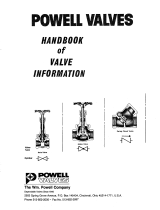
NIBCO Technical Services • Phone: 1.888.446.4224 • Fax: 1.888.336.4224
7
and possibly reduce the amount of leakage. Critical to good valve performance is to
keep the surfaces flat and not to change the angle of the wedge or body seats.
4.3 LEAKAGE THROUGH THE STUFFING BOX
Leakage through the stuffing box packing may be stopped by tightening the packing
nuts. Excessive tightening may cause difficult operation of the valve and could cause
damage to the stem or packing nut. Do not over tighten. The adjustment should be just
tight enough to stop the leak.
If the pack gland follower has run out of travel, isolate and depressurize the valve for
repacking or the addition of more packing.
Repacking of valves under pressure is not a recommended practice. This is dangerous
and could result in serious injury even if the valve appears to be back-seated. Foreign
matter may have accumulated on the back seat, or by accident the stem could be
knocked off the back seat position, thereby allowing maintenance personnel to be
exposed to potentially dangerous fluids, imder pressure which could result in serious
injury. Prior to proceeding to change packing, it will be necessary to shut down the
piping system, remove pressure and drain, and if necessary, allow to cool and/or
decontaminate before working on the valve.
For non-rising stem valves (F-619, F-619-N, F-639-31, F-639-33), remove the
handwheel nut, I.D. plate, handwheel, the top two nuts (packing nuts), pack gland
follower, and pack gland to remove or add to packing. Remove the packing being careful
not to scratch the stem or the inside of the packing well.
For rising stem valves (F-617-0, F-617-ON, F-637-31, F-637-33, F-617-13, F-667-0), it is
not necessary to remove the handwheel. Remove the packing nuts and bolts, slide the
pack gland follower, pack gland up out of the way and keep out of the way with tape or
some other convenient temporary method.
If the packing is removed, discard and do not try to put it back once it has been
removed. Reusing old packing is a gamble not worth taking. Clean the stem and
examine it for damage. Install the new packing, which may either be rope packing or cut
rings. Rope packing is sometimes spiral wound around the stem and pushed into the
stuffing box. If rope is used, make sure there is enough put into the packing chamber so
a little bit will stick up over the top. When the packing is compressed by the gland it
should then be slightly lower than the top, If rings are used, install one ring at a time with
the diagonal cut in each ring being staggered 90° away from the cut in the ring below.
Each ring should be firmly compressed in the stuffing box after it is placed in position
before the next ring is added. Install the packing gland and pack gland follower, packing
nuts, and tighten down. The packing nut should be tightened only enough to prevent
leakage. Pressurize the valve and check the packing for leakage. Retighten as required.


















